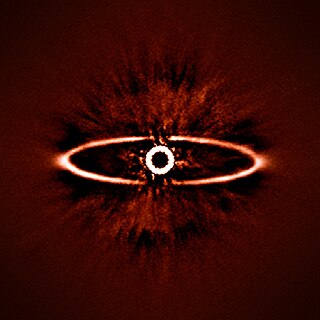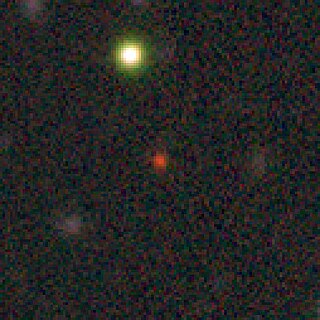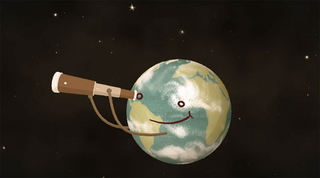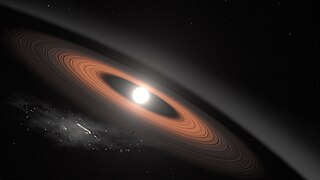
Brown dwarfs are substellar objects that have more mass than the biggest gas giant planets, but less than the least massive main-sequence stars. Their mass is approximately 13 to 80 times that of Jupiter (MJ)—not big enough to sustain nuclear fusion of ordinary hydrogen (1H) into helium in their cores, but massive enough to emit some light and heat from the fusion of deuterium (2H). The most massive ones can fuse lithium (7Li).

A rogueplanet, also termed a free-floating planet (FFP) or an isolated planetary-mass object (iPMO), is an interstellar object of planetary mass which is not gravitationally bound to any star or brown dwarf.

A subdwarf, sometimes denoted by "sd", is a star with luminosity class VI under the Yerkes spectral classification system. They are defined as stars with luminosity 1.5 to 2 magnitudes lower than that of main-sequence stars of the same spectral type. On a Hertzsprung–Russell diagram subdwarfs appear to lie below the main sequence.

NGC 2547 is a southern open cluster in Vela, discovered by Nicolas Louis de Lacaille in 1751 from South Africa. The star cluster is young with an age of 20-30 million years.

HR 4796 is a binary star system in the southern constellation of Centaurus. Parallax measurements put it at a distance of 235 light-years from the Earth. The two components of this system have an angular separation of 7.7 arcseconds, which, at their estimated distance, is equivalent to a projected separation of about 560 Astronomical Units (AU), or 560 times the separation of the Earth from the Sun. The star and its ring resemble an eye, and it is sometimes known by the nickname "Sauron's Eye".
WISE J0521+1025 is a nearby brown dwarf of spectral type T7.5, located in the constellation Orion at approximately 21.7 light-years from Earth.

HD 115600 is a star in the constellation Centaurus and a member of the Scorpius–Centaurus association, the nearest OB association to the Sun and the host star of a bright Kuiper belt-like debris ring.
2MASS J11193254–1137466 AB is a planetary mass binary located 86±23 light-years from the Earth in the constellation Crater. The components of 2MASS J1119–1137 are each roughly four Jupiter masses. The planetary-mass objects are probably a part of the TW Hydrae association which has an age of approximately 10 million years. The planetary-mass objects are candidate rogue planets.

WISEA J114724.10−204021.3 is a brown dwarf in the TW Hydrae association, a nearby group of very young stars and brown dwarfs. The object is notable because its estimate mass, 6±1 times the mass of Jupiter, places it in the mass range for rogue planets. Nevertheless, it is a free-floating object, unassociated with any star system.
HD 74389 is a double star system approximately 425 light years from Earth. The primary, HD 74389 A, was initially listed in the Hipparcos catalog as an A0V spectral type star, but this was subsequently updated in 1990 as A2V when Sanduleak and Pesch imaged it with the Burrell Schmidt telescope at Kitt Peak.

WISE J080822.18-644357.3, also called J0808, is a 45+11
−7 Myr old star system in the Carina constellation with a circumstellar debris disk orbiting an M-type red dwarf about 331 lightyears from Earth.

Backyard Worlds: Planet 9 is a NASA-funded citizen science project which is part of the Zooniverse web portal. It aims to discover new brown dwarfs, faint objects that are less massive than stars, some of which might be among the nearest neighbors of the Solar System, and might conceivably detect the hypothesized Planet Nine. The project's principal investigator is Marc Kuchner, an astrophysicist at NASA's Goddard Space Flight Center.

WISEA 1101+5400 is a T-type brown dwarf approximately 100 light-years away in the constellation Ursa Major. It was discovered in March 2017 by members of the citizen science project Backyard Worlds. Initial photometric analysis suggested it was a T5.5 dwarf, which was later confirmed by a spectrum of the object obtained with the NASA Infrared Telescope Facility. It is the first confirmed brown dwarf found by the project.

LSPM J0207+3331 is, as of 2023, the oldest and coldest known white dwarf star to host a circumstellar disk, located 145 light-years from Earth. It was discovered in October 2018 by a volunteer participating in the Backyard Worlds citizen science project.
A Peter Pan disk is a circumstellar disk around a star or brown dwarf that appears to have retained enough gas to form a gas giant planet for much longer than the typically assumed gas dispersal timescale of approximately 5 million years. Several examples of such disks have been observed to orbit stars with spectral types of M or later. The presence of gas around these disks has generally been inferred from the total amount of radiation emitted from the disk at infrared wavelengths, and/or spectroscopic signatures of hydrogen accreting onto the star. To fit one specific definition of a Peter Pan disk, the source needs to have an infrared "color" of , an age of >20 Myr and spectroscopic evidence of accretion.

The Tucana-Horologium association (Tuc-Hor), or Tucana Horologium moving group, is a stellar association with an age of 45 ± 4 Myr and it is one of the largest stellar associations within 100 parsecs. The association has a similar size to the Beta Pictoris moving group (BPMG) and contains, like BPMG, more than 12 stars with spectral type B, A and F. The association is named after two southern constellations, the constellation Tucana and the constellation Horologium.

Planet Patrol is a NASA citizen science project available in Zooniverse and aimed at discovering new exoplanets with data from the TESS telescope.

WISEA J181006.18-101000.5 or WISEA 1810-1010 is a substellar object in the constellation Serpens about 8.9 parsec or 29 light-years distant from earth. It stands out because of its peculiar colors matching both L-type and T-type objects, likely due to its very low metallicity. Together with WISEA 0414−5854 it is the first discovered extreme subdwarf (esd) of spectral type T. Lodieu et al. describe WISEA 1810-1010 as a water vapor dwarf due to its atmosphere being dominated by hydrogen and water vapor.

WISEA J120037.79-784508.3, also called W1200-7845 or 2MASS J12003792-7845082, is a brown dwarf with a primordial disk 333.73 ± 3.13 lightyears from Earth in the 3.7+4.6
−1.4 Myr-old ε Chamaeleontis association, currently making it the closest known brown dwarf with an associated circumstellar disk. It was discovered by citizen scientists in 2020 volunteering for the Disk Detective project.

















